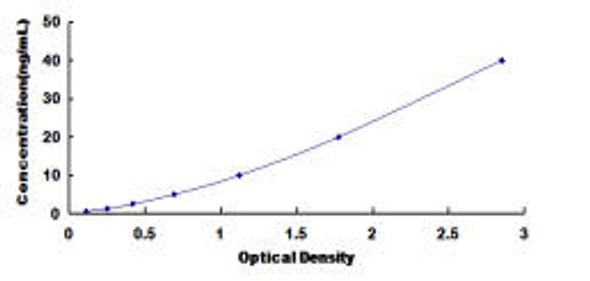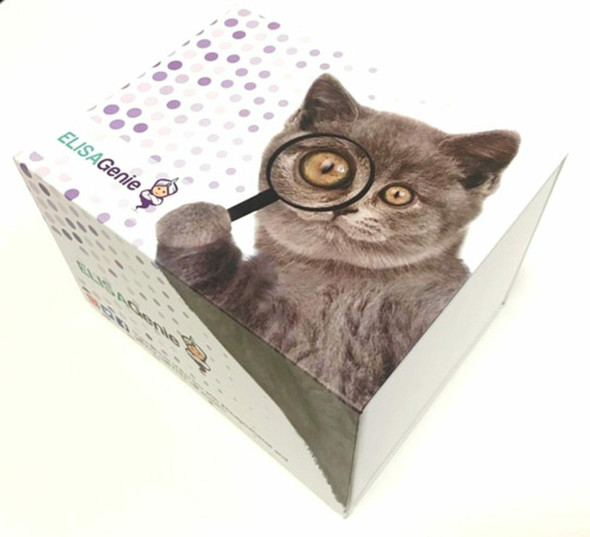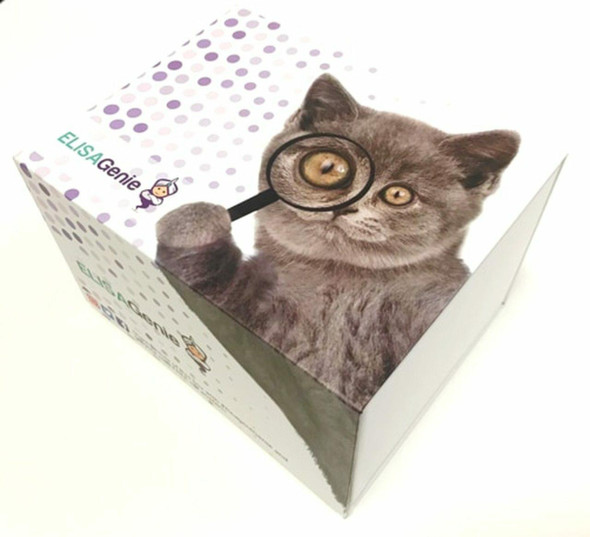Human Cell Biology ELISA Kits 5
Human AGC (Aggrecan) ELISA Kit (HUES01524)
- SKU:
- HUES01524
- Product Type:
- ELISA Kit
- Size:
- 96 Assays
- Uniprot:
- P16112
- Sensitivity:
- 0.09ng/mL
- Range:
- 0.16-10ng/mL
- ELISA Type:
- Sandwich
- Synonyms:
- ACAN, AGC1, AGCAN, CSPG1, CSPGCP, MSK16, SEDK, cartilage-specific proteoglycan core protein, chondroitin sulfate proteoglycan 1
- Reactivity:
- Human
- Sample Type:
- Serum, plasma and other biological fluids
- Research Area:
- Cell Biology
Description
| Assay type: | Sandwich |
| Format: | 96T |
| Assay time: | 4.5h |
| Reactivity: | Human |
| Detection Method: | Colormetric |
| Detection Range: | 0.16-10 ng/mL |
| Sensitivity: | 0.10 ng/mL |
| Sample Volume Required Per Well: | 100µL |
| Sample Type: | Serum, plasma and other biological fluids |
| Specificity: | This kit recognizes Human AGC in samples. No significant cross-reactivity or interference between Human AGC and analogues was observed. |
This ELISA kit uses Sandwich-ELISA as the method. The micro ELISA plate provided in this kit has been pre-coated with an antibody specific to Human AGC. Standards or samples are added to the appropriate micro ELISA plate wells and combined with the specific antibody. Then a biotinylated detection antibody specific for Human AGC and Avidin-Horseradish Peroxidase (HRP) conjugate are added to each micro plate well successively and incubated. Free components are washed away. The substrate solution is added to each well. Only those wells that contain Human AGC, biotinylated detection antibody and Avidin-HRP conjugate will appear blue in color. The enzyme-substrate reaction is terminated by adding Stop Solution and the color turns yellow. The optical density (OD) is measured spectrophotometrically at a wavelength of 450 nm ± 2 nm. The OD value is proportional to the concentration of Human AGC. The concentration of Human AGC in samples can be calculated by comparing the OD of the samples to the standard curve.
| UniProt Protein Function: | ACAN: This proteoglycan is a major component of extracellular matrix of cartilagenous tissues. A major function of this protein is to resist compression in cartilage. It binds avidly to hyaluronic acid via an N-terminal globular region. Defects in ACAN are the cause of spondyloepiphyseal dysplasia type Kimberley (SEDK). Spondyloepiphyseal dysplasias are a heterogeneous group of congenital chondrodysplasias that specifically affect epiphyses and vertebrae. The autosomal dominant SEDK is associated with premature degenerative arthropathy. Defects in ACAN are the cause of spondyloepimetaphyseal dysplasia aggrecan type (SEMD-ACAN). A bone disease characterized by severe short stature, macrocephaly, severe midface hypoplasia, short neck, barrel chest and brachydactyly. The radiological findings comprise long bones with generalized irregular epiphyses with widened metaphyses, especially at the knees, platyspondyly, and multiple cervical-vertebral clefts. Defects in ACAN are the cause of osteochondritis dissecans short stature and early-onset osteoarthritis (OD). It is a type of osteochondritis defined as a separation of cartilage and subchondral bone from the surrounding tissue, primarily affecting the knee, ankle and elbow joints. It is clinically characterized by multiple osteochondritic lesions in knees and/or hips and/or elbows, disproportionate short stature and early-onset osteoarthritis. Belongs to the aggrecan/versican proteoglycan family. 3 isoforms of the human protein are produced by alternative splicing. |
| UniProt Protein Details: | Protein type:Cell adhesion; Extracellular matrix; Secreted; Secreted, signal peptide Chromosomal Location of Human Ortholog: 15q26. 1 Cellular Component: extracellular matrix; lysosomal lumen; proteinaceous extracellular matrix; Golgi lumen; extracellular region Molecular Function:protein binding; metal ion binding; extracellular matrix structural constituent; hyaluronic acid binding; carbohydrate binding Biological Process: keratan sulfate metabolic process; extracellular matrix disassembly; extracellular matrix organization and biogenesis; glycosaminoglycan metabolic process; carbohydrate metabolic process; keratan sulfate biosynthetic process; pathogenesis; keratan sulfate catabolic process; cell adhesion; proteolysis; skeletal development Disease: Spondyloepiphyseal Dysplasia, Kimberley Type; Osteochondritis Dissecans, Short Stature, And Early-onset Osteoarthritis; Spondyloepimetaphyseal Dysplasia, Aggrecan Type |
| UniProt Code: | P16112 |
| NCBI GenInfo Identifier: | 129886 |
| NCBI Gene ID: | |
| NCBI Accession: | P16112. 2 |
| Molecular Weight: | |
| NCBI Full Name: | Aggrecan core protein |
| UniProt Protein Name: | Aggrecan core protein |
| UniProt Synonym Protein Names: | Cartilage-specific proteoglycan core protein; CSPCP; Chondroitin sulfate proteoglycan core protein 1 |
| UniProt Gene Name: | ACAN |
| UniProt Entry Name: | PGCA_HUMAN |
As the OD values of the standard curve may vary according to the conditions of the actual assay performance (e. g. operator, pipetting technique, washing technique or temperature effects), the operator should establish a standard curve for each test. Typical standard curve and data is provided below for reference only.
| Concentration (ng/mL) | O.D | Average | Corrected |
| 10 | 2.442 2.454 | 2.448 | 2.383 |
| 5 | 1.606 1.662 | 1.634 | 1.569 |
| 2.5 | 0.951 0.931 | 0.941 | 0.876 |
| 1.25 | 0.473 0.489 | 0.481 | 0.416 |
| 0.63 | 0.289 0.267 | 0.278 | 0.213 |
| 0.32 | 0.173 0.165 | 0.169 | 0.104 |
| 0.16 | 0.109 0.127 | 0.118 | 0.053 |
| 0 | 0.056 0.074 | 0.065 | -- |
Precision
Intra-assay Precision (Precision within an assay): 3 samples with low, mid range and high level Human AGC were tested 20 times on one plate, respectively.
Inter-assay Precision (Precision between assays): 3 samples with low, mid range and high level Human AGC were tested on 3 different plates, 20 replicates in each plate.
| Intra-assay Precision | Inter-assay Precision | |||||
| Sample | 1 | 2 | 3 | 1 | 2 | 3 |
| n | 20 | 20 | 20 | 20 | 20 | 20 |
| Mean (ng/mL) | 0.47 | 1.27 | 4.51 | 0.45 | 1.17 | 4.12 |
| Standard deviation | 0.03 | 0.07 | 0.24 | 0.03 | 0.07 | 0.14 |
| C V (%) | 6.38 | 5.51 | 5.32 | 6.67 | 5.98 | 3.40 |
Recovery
The recovery of Human AGC spiked at three different levels in samples throughout the range of the assay was evaluated in various matrices.
| Sample Type | Range (%) | Average Recovery (%) |
| Serum (n=5) | 89-104 | 96 |
| EDTA plasma (n=5) | 92-104 | 97 |
| Cell culture media (n=5) | 91-104 | 97 |
Linearity
Samples were spiked with high concentrations of Human AGC and diluted with Reference Standard & Sample Diluent to produce samples with values within the range of the assay.
| Serum (n=5) | EDTA plasma (n=5) | Cell culture media (n=5) | ||
| 1:2 | Range (%) | 95-107 | 98-111 | 89-104 |
| Average (%) | 101 | 104 | 97 | |
| 1:4 | Range (%) | 88-98 | 80-91 | 89-104 |
| Average (%) | 93 | 87 | 95 | |
| 1:8 | Range (%) | 87-100 | 85-99 | 86-101 |
| Average (%) | 93 | 90 | 92 | |
| 1:16 | Range (%) | 89-100 | 84-97 | 89-100 |
| Average (%) | 94 | 90 | 94 |
An unopened kit can be stored at 4°C for 1 month. If the kit is not used within 1 month, store the items separately according to the following conditions once the kit is received.
| Item | Specifications | Storage |
| Micro ELISA Plate(Dismountable) | 8 wells ×12 strips | -20°C, 6 months |
| Reference Standard | 2 vials | |
| Concentrated Biotinylated Detection Ab (100×) | 1 vial, 120 µL | |
| Concentrated HRP Conjugate (100×) | 1 vial, 120 µL | -20°C(shading light), 6 months |
| Reference Standard & Sample Diluent | 1 vial, 20 mL | 4°C, 6 months |
| Biotinylated Detection Ab Diluent | 1 vial, 14 mL | |
| HRP Conjugate Diluent | 1 vial, 14 mL | |
| Concentrated Wash Buffer (25×) | 1 vial, 30 mL | |
| Substrate Reagent | 1 vial, 10 mL | 4°C(shading light) |
| Stop Solution | 1 vial, 10 mL | 4°C |
| Plate Sealer | 5 pieces | |
| Product Description | 1 copy | |
| Certificate of Analysis | 1 copy |
- Set standard, test sample and control (zero) wells on the pre-coated plate and record theirpositions. It is recommended to measure each standard and sample in duplicate. Note: addall solutions to the bottom of the plate wells while avoiding contact with the well walls. Ensuresolutions do not foam when adding to the wells.
- Aliquot 100 µL of standard solutions into the standard wells.
- Add 100 µL of Sample / Standard dilution buffer into the control (zero) well.
- Add 100 µL of properly diluted sample (serum, plasma, tissue homogenates and otherbiological fluids) into test sample wells.
- Cover the plate with the sealer provided in the kit and incubate for 90 min at 37 °C.
- Aspirate the liquid from each well, do not wash. Immediately add 100 µL of BiotinylatedDetection Ab working solution to each well. Cover the plate with a plate seal and gently mix. Incubate for 1 hour at 37 °C.
- Aspirate or decant the solution from the plate and add 350 µL of wash buffer to each welland incubate for 1-2 minutes at room temperature. Aspirate the solution from each well andclap the plate on absorbent filter paper to dry. Repeat this process 3 times. Note: a microplatewasher can be used in this step and other wash steps.
- Add 100 µL of HRP Conjugate working solution to each well. Cover with a plate seal andincubate for 30 min at 37 °C.
- Aspirate or decant the solution from each well. Repeat the wash process for five times asconducted in step 7.
- Add 90 µL of Substrate Reagent to each well. Cover with a new plate seal and incubate forapproximately 15 min at 37 °C. Protect the plate from light. Note: the reaction time can beshortened or extended according to the actual color change, but not by more than 30min.
- Add 50 µL of Stop Solution to each well. Note: Adding the stop solution should be done inthe same order as the substrate solution.
- Determine the optical density (OD value) of each well immediately with a microplate readerset at 450 nm.






